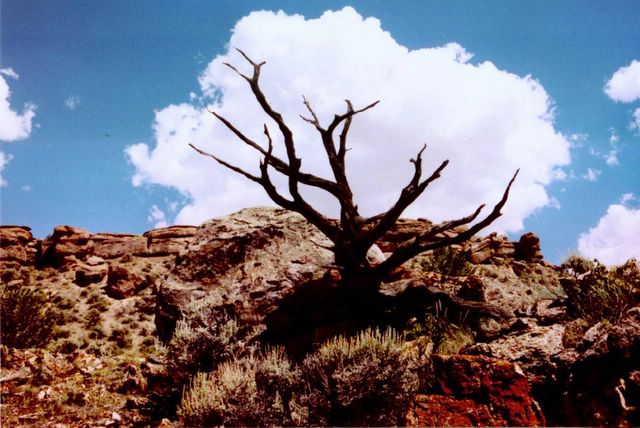
In honor of Ascension Sunday, I share with you my favorite Dali painting. I read somewhere that the background is the ecstatic vision Dali had of the nucleus of an atom. I wonder what he could be saying about Christ or this event to combine the two images. Let me know what you think. I interpret it as saying the Christ is the central or elemental reality of life...you know, "through whom all things came into being..." or something like that.
I also like that Jesus' feet are the main focus of the painting. I preached a sermon on this one time called "Jesus Walks" I read that this perspective was a tribute to Mantegna's Dead Christ (below), which he admired and considered a precursor to his own form of art.

I also like that the Shekinah is portrayed in the feminine, as She should be, (at least I'm assuming that's what Dali was portraying by the face of the woman) and that She is fused with the Dove imagery for the Holy Spirit, who is descending as Jesus ascends. They're kind of passing each other along the way, like "okay, your turn!"
Also, Jesus' hands--they look like they are clutched in pain, perhaps. What do you make of them?











I have always loved that Mantegna piece. It is amazing what just a slight change in perspective can do. There's a great sermon in there, eh?
ReplyDeleteThe woman is Gala, Dali's wife and muse. Christ is holding the Universe together with his clenched hands, and the figure behind him is the cell nucleus.
ReplyDeleteWow! Thanks for the perspective on Shekhina! Regarding your search for input on Jesus's hands in this painting... Take a look at Dali's Christ of St. John of the Cross, which was inspired by a sketch by a Spanish Friar in the 1577 (I think) named St. John of the Cross. The sketch is of a vision the friar had of God looking down watching as Jesus was crucified. What I notice is that the hands in both paintings are configured similarly... I assumed from the crucifixion image they were clenched in agony, but now I am unsure... I also notice that there are no nails in the crucifixion painting, nor holes in this ascension image. I don't know, but it kinda says to me that Christ was pinned to the cross by his own desire to save us and that no nails are needed for him to suffer and stay up on the cross... What do you think about the absence of nails in both works?
ReplyDeleteThis comment has been removed by the author.
ReplyDeleteThanks for the comments everyone. I'm currently reeling from the experience of creating a very thorough response to your comments, and then when I tried to post, I first had to log in. When it returned me to the comments--mine was all gone.
ReplyDeleteBasically, what I wanted to say was that though I couldn't find the St. John of the Cross sketch, I did find this bit of information regarding Dali's re-imagining of it:
On the bottom of his studies for the painting, Dalí explained its inspiration: "In the first place, in 1950, I had a 'cosmic dream' in which I saw this image in colour and which in my dream represented the 'nucleus of the atom.' This nucleus later took on a metaphysical sense; I considered it 'the very unity of the universe,' the Christ!"[2] Sounds like he must've carried that same dream into this presentation too (The Ascension was painted 7 years later than St. John of the Cross) It's neat to find out you're on the right track regarding an artist's intentions after the fact.
Regarding the nail holes and blood, I also came across this bit of information on wikipedia regarding Christ of St. John of the Cross, "Although it is a depiction of the crucifixion, it is devoid of nails, blood, and a crown of thorns, because, according to Dalí, he was convinced by a dream that these features would mar his depiction of Christ." Latest anonymous--I think your idea of why he avoided that depiction is quite compelling.
Earlier anonymous. Your comment on the hands representing holding the universe together got me thinking. Look how the nucleus encompasses Christ, and then slightly dips down into the water below. Not sure if Dali was going for this, or not, but it seems to me that here is a depiction not only of the ascension, but also of the creation, as told in Genesis and in John 1. The vibrancy of the sky is connected to the "watery void" below (Process theology's influence on me has led me to speak less in terms of Creatio ex nihilo, and instead in terms of Creatio ex chaos, but no doubt Dali had internalized creatio ex nihilo--the waters below do look more void than chaotic if he did intend this metaphor after all.) As Genesis 1 says, God creates the universe through speaking, and John 1 writes that it is the same creative Word of God "through whom all things came into being" (and John of course was tapping into a broader stream of "Logos philosophy") who is "made flesh" (incarnated, coming in atomic substance) who finally unites God and creation in a new and salvivic way. Notice how the nucleus just barely dips into the water--it's not a full infusing of God into creation, but it is a channel.
And lastly, look at the two primary circles. The white one encompasses Christ and the dove, and the other one, represented by the cell nucleus encompassing Christ and the water at about the same "level" as the dove is taking at the top of the "Divine Circle". Christ is the mystical bridge. Thanks for further "fleshing this out!"